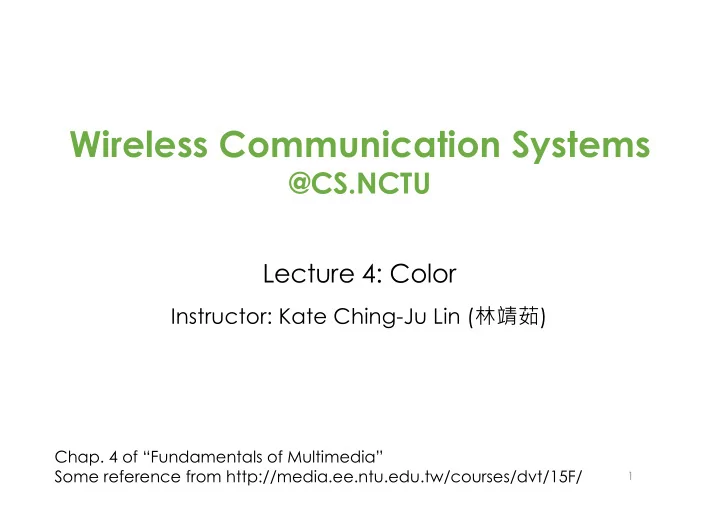

Wireless Communication Systems @CS.NCTU Lecture 4: Color Instructor: Kate Ching-Ju Lin ( 林靖茹 ) Chap. 4 of “Fundamentals of Multimedia” Some reference from http://media.ee.ntu.edu.tw/courses/dvt/15F/ 1
Outline • Human Vision • Color model • Attributes 2
Colors • Light is an electromagnetic wave • Color is the wavelength of the light wave • Human visible light • wavelength 370 – 780 nm • Frequency spectrum
Colors • Laser light consists of a single wavelength • Pure color • Most light sources are a combination of wavelength • Spectral analysis via spectrophotometer shows the contribution of each wavelength dispersion
Human Vision • Human eye likes a camera • Lens focusing an image onto the retina • Retina consists of • An array of rods • Three kinds of cones, sensitive to R, G, B, respectively • ~6 million cones, proportion of R, G, and B cones is 40:20:1 • Eye is most sensitive to light in the middle of the visible spectrum 5
Outline • Human Vision • Color model • Attributes 6
RGB Color model • Additive color model • Y=R+G, M=B+R, C=B+G • Create a wide range of color by combining the three primary colors • Primary colors: cannot be generated from each other • Human eyes are most sensitive to RGB • The retina consists of sensing cells known as rods and cones. • More sensitive to green • Less sensitive to blue
RGB Color Model • Usually 8 bits per color channel • How to increase brightness (intensity)? • Increase each component with the same ratio • RGB(50,100,200) RGB(25,50,100) • Grayscale values on the cube’s diagonal from (0,0,0) to (1,1,1) • Same value for RGB(L, L, L), 0 ≤ L ≤ 1 • RGB to grayscale conversion • (R, G, B) à (L, L, L) L = 0.30 R + 0.59 G + 0.11 B • Because human eyes are more sensitive to green
CMY Color Model • CMY (Cyan, Magenta, Yellow) are complements of R,G,B • C=1-R, M=1-G, Y=1-B • Subtractive color model • The origin of the cube is white • CMYK is used in color printers • K: black • Lay down transparent layers of ink onto a white paper 9
YUV Color Model • Historically, the terms YUV were used for analog encoding in television systems • YUV used for TV in Europe (PAL) • Also known as Luminance and Chrominance Color Models • Put all luminance information in one value (Y) • All color (chrominance) information in other two (UV) • Human eyes are more sensitive to Y than UV 10
Y’UV Color Model • Y’: luma (electronic brightness) • https://en.wikipedia.org/wiki/YUV • Grey value of an image • An image becomes gray level if U and V are set to zero • UV: chrominance • Difference between a color and a reference white are the same luminance • U = B’ – Y’ • V = R’ – Y’ • B’, R’ are B and R after gamma correction 11
Y’UV Color Model • Y’UV and RGB conversion 12
YIQ Color Model • Actually Y’IQ model • YIQ used for TV in North America and Japan • I: In-phase chrominance • Q: quadrature chrominance • A version of YUV, with the same Y’ but with U and V rotated by 33 ∘ 13
YCbCr • Used in digital image/video (JPEG and MPEG) • When refer to signals in video or digital form, the term YUV mostly means YCbCr • Cb and Cr are just U and V, but with scaling and shift such that the values are between 0 and 255 • The CbCr plane at constant luma Y ′ =0.5 14
Outline • Human Vision • Color model • Attributes 15
Color Appearance • Five perceptual attributes • Brightness: the attribute according to which an area appears to more or less intense • Lightness: the brightness of an area relative to a similarly illuminated area that appears to be white • Colorfulness (Chromaticness): the attribute according to which an area appears to be more or less chromatic • Chroma: the colorfulness of an area relative to a similarly illuminated area that appears to be white • Hue: the attribute of a color denoted by its name such as blue, green, yellow, orange, etc • Increasing the illumination increases the brightness and colorfulness of a stimulus, while the lightness and chroma remain approximately constant
Color Representation • There are three main perceptual attributes of colors: brightness (V), hue(H), and saturation(S) . • Brightness is the perceived luminance • Hue is an attribute we commonly describe as blue, red, green, etc • Saturation is our impression how different the color is from achromatic (white or gray) color
Color Attributes different brightness levels (dark to bright) different hues (red to violet) saturation (the dark blue at the left side is highly saturated whereas the faded blue at the right side has low saturation)
Summary • Different methods for representing colors • Additive (three primary colors: R, G, B) • Used in digital cameras, monitors, TVs • Subtractive (three primary colors: C, M, Y Plus K) • Good for printers • Luminance & Chrominance: YIQ, YUV, YCbCr • Luminance component (Y) and two chrominance components • YIQ & YUV used in B&W and color TV (same signal) • YCbCr used in JPEG and MPEG compressions 19
Recommend
More recommend